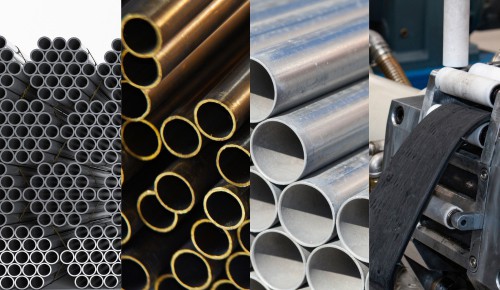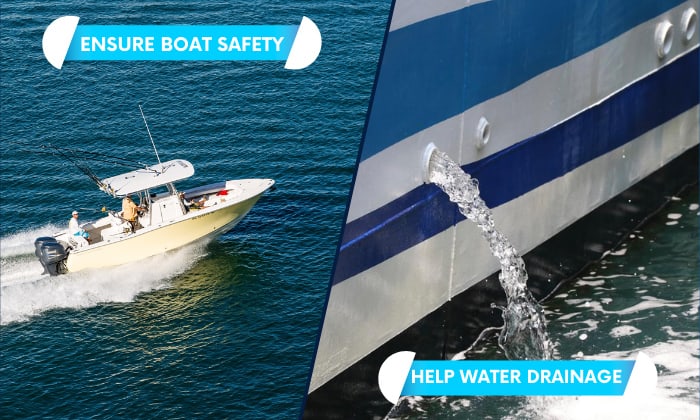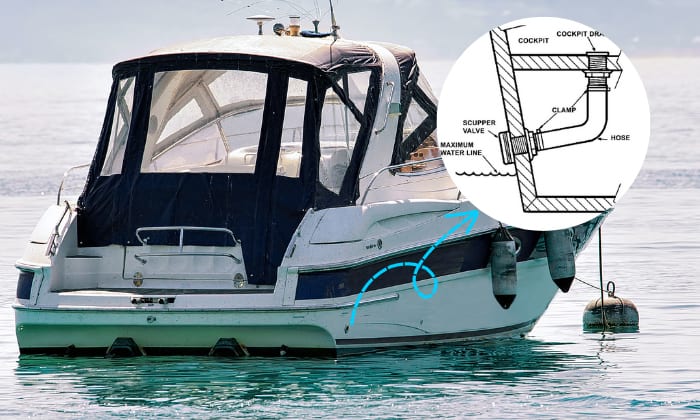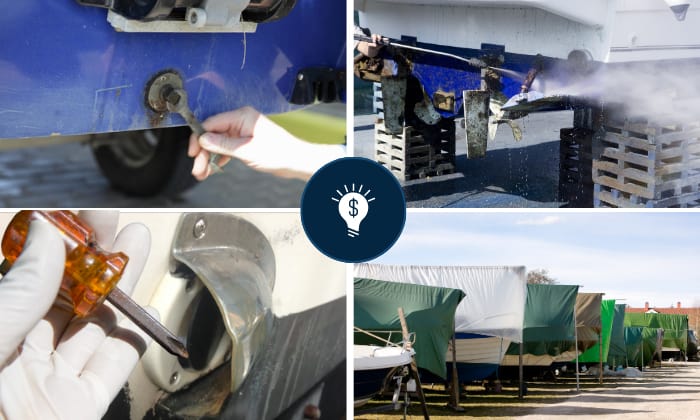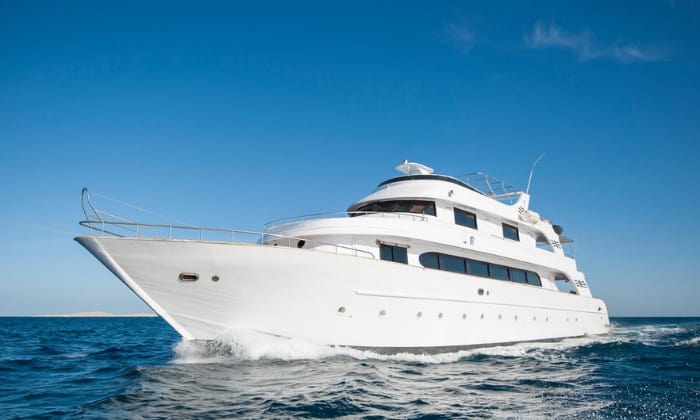“What is a scupper on a boat?” is a common question of many greenhorn boaters. It’s understandable because the boating world has many terminologies alien to the ordinary person.
As one sets foot on a boat, whether the watercraft is a sleek sailboat gliding through the waves or a sturdy fishing vessel battling the open seas, there will always be small holes lining the deck or the transom. These are called scuppers—a vital component for draining the water on the boat.
Table of Contents
Defining Boat Scuppers
A straightforward scupper definition describes a small port or opening on a vessel’s hull to ensure water doesn’t accumulate on the vessel.
While their significance often goes unnoticed by casual observers, understanding what scuppers are and their purpose is crucial for anyone venturing into the world of boating.
1. Typical scupper design and location on boats
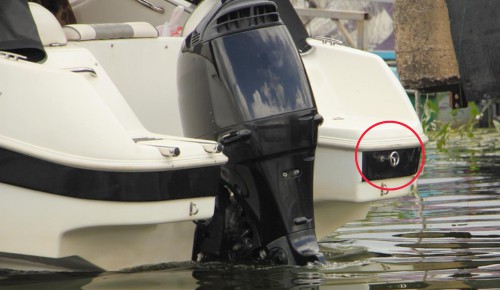
Scuppers, typically found on the lowest point of the deck or along the transom, serve as drainage outlets that let water flow out of a boat to avoid accumulating on its surface. As such, boat scuppers below waterline usually are not a good idea—they may not do their job properly. To be clear, these components should be ¾ submerged at most.
A scupper’s primary function is to expel excess water, like rain, seawater, or any fluid that may find its way aboard. By draining water, scuppers help maintain a boat’s stability, prevent waterlogging damage, and ensure the safety of passengers and crew.
On that note, the term scuppered define excess water movement to, through, and from the vessel.
2. Materials used in scupper construction
Boat manufacturers use various materials for scupper plumbing to guarantee durability, functionality, and resistance to unpredictable marine environments. The choice of materials for scuppers depends on factors like boat type, its purpose, and the specific design requirements.
- Stainless steel and Brass
Stainless steel is popular due to its excellent corrosion resistance and strength. It can withstand prolonged exposure to saltwater and is highly durable. Brass is another material commonly used for scuppers.
- Aluminum
Aluminum scuppers are lightweight and corrosion-resistant, making them suitable for a wide range of boats. The downside is that aluminum can be prone to galvanic corrosion, making proper insulation or isolation measures necessary to prevent such occurrences.
- Rubber or PVC
Rubber or PVC materials are used as scupper flaps or valves. The flexibility of rubber or PVC ensures a tight seal when the scupper is not in use and enables easy passage of water during drainage.
Role of Scuppers
Scuppers play a role in ensuring watercraft safety and optimum excess water drainage.
- For boat safety
Scuppers ensure boat safety by effectively managing water drainage by preventing it from pooling and potentially causing flooding. By quickly and efficiently removing water, scuppers help keep the stability and buoyancy of the boat, reducing the risk of it sinking or getting swamped.
The extra water on the deck can affect a boat’s stability since it increases the weight and can cause an imbalance in load distribution.
- In boat drainage
Scuppers allow water to flow out of the boat, reducing the likelihood of accidents caused by wet and slippery surfaces. This helps prevent injuries and ensures the safety of everyone on board, from fishing boats to superyachts.
How a Scupper Works
When water pools on a boat’s deck, it flows toward and out of the scupper openings, which feature a one-way valve to ensure water outside doesn’t backflow.
Scuppers are typically positioned at the lowest points on the deck or along the boat’s transom, relying on the force of gravity to encourage scupper ship water drainage. As water collects near the scupper openings, gravity pulls it toward the exit point or the holes.
Once the water reaches the opening, it flows out of the boat. The water exits either directly overboard or through a drainage system connected to the scupper, since some will come with a hosepipe bottom.
Types of Scuppers and Their Designs
At least four types of boat scuppers exist. Each caters to distinct boat configurations, purposes, and drainage needs.
- Open
Open scuppers are the most traditional type. They consist of round or rectangular slots in the boat’s deck or transom, allowing water to stream freely out of the boat. Open scuppers are often found on small recreational boats, such as kayaks.
One problem with open scuppers is that they don’t have a one-way valve, so a strong force can push water through these holes. As such, you may need a plug to seal the hole and only open it when necessary.
- Flapped
Flapped scuppers incorporate a hinged flap or valve mechanism that allows water to rush out of the boat while stopping it from re-entering. These flaps open if there’s water pressure coming from the inside and close when there is no water, sealing the scupper to prevent backflow.
When choosing this type of scupper, make sure the flap is sturdy without being overly stiff. Otherwise, it won’t seal well, meaning it’ll allow water to backflow.
- Through-hull
Through-hull scuppers extend through the boat’s hull, with the scupper outlet positioned outside the vessel. They are often used in larger boats since they are sufficient to handle high volumes of water.
- Recessed
Recessed scuppers are designed to be barely below the boat’s deck surface, creating a shallow well around the scupper opening. This structure helps prevent water from spilling back onto the deck and allows for efficient drainage even when the boat is heeling or in rough sea conditions.
Scupper Installation and Maintenance Tips
Here are some tips for effective scupper installation and maintenance.
- Installation Tips
- Install scuppers at the lowest points on the boat’s deck or transom where water is likely to accumulate.
- Choose scuppers for the right boat size and capacity based on the boat’s dimensions, intended use, and expected water drainage requirements.
- Reinforce the scupper section to maintain structural integrity and avoid water seepage.
- Maintenance Tips
- Inspect scuppers for any signs of damage, blockages, or wear.
- Check for debris, like leaves, twigs, or dirt, that may obstruct water flow and remove any obstructions to maintain proper drainage.
- Clean the scuppers regularly with mild soapy water and a soft brush to remove accumulated dirt, grime, or salt deposits.
- Observe proper winterization procedures (including the scuppers) before storing the boat.
Frequently Asked Questions
Can scuppers get clogged? How to prevent it?
Yes, scuppers can indeed get clogged. For instance, the accumulated water onboard can carry large debris that ultimately gets stuck in the scupper. You can prevent this from happening by installing mesh screens to stop large debris from entering.
Are scuppers necessary for all types of boats?
No, not all boat types need scuppers. Scupper requirements vary depending on the specific design and purpose of the craft. While some boats require scuppers for proper water drainage and safety, other vessel types may not rely on these components due to their structure or alternative drainage methods.
It is necessary to note that even if a boat does not have scuppers, it should still have proper drainage systems or mechanisms to remove water and maintain safety.
How many scuppers should a boat have?
While there is no one-size-fits-all answer, a broad guideline is to have multiple scuppers positioned at the lowest points on the boat’s deck based on the boat’s dimensions and the expected level of water drainage efficiency.
To be clear, a larger boat will require more scuppers, especially if it’s used in regions with rough waters or frequent heavy rains.
Scupper accessories and modifications?
If traveling in regions with rough currents, consider installing a valve, which will ensure that the water doesn’t get inside your boat. It’s also useful when opting for in-water boat storage. And as mentioned above, mesh screens are a handy modification if clogged scuppers are a frequent issue.
Conclusion
Now that what is a scupper on a boat question is answered, it is, in the end, established how essential they are. These vessel elements might look nothing more than drainage holes, but their function translates to a safer voyage.
Regular maintenance is needed to ensure scuppers remain free of debris that may hinder water flow. Keeping scuppers clean and clear allows for efficient drainage and prevents potential blockages that could lead to flooding and compromise the boater’s safety.

Ten years of enjoying countless trips on boats never made me love them any less! So I am here to put all those experiences into good use for other boaters who want to have a safe and fun trip with their friends and families.


